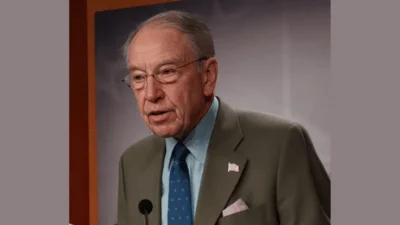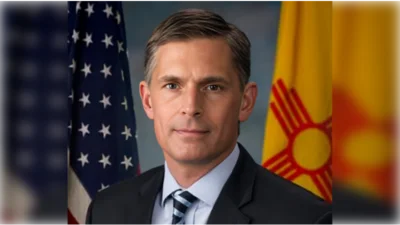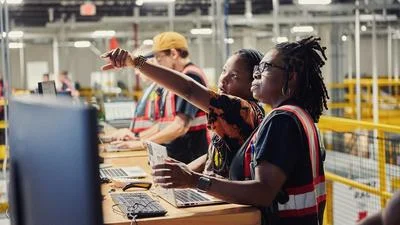The Congressional Record is a unique source of public documentation. It started in 1873, documenting nearly all the major and minor policies being discussed and debated.
“NAFTA AND THE DRUG TRADE” mentioning the U.S. Dept of State was published in the House of Representatives section on pages H865-H867 on Jan. 23, 2007.
The publication is reproduced in full below:
NAFTA AND THE DRUG TRADE
The SPEAKER pro tempore. Under a previous order of the House, the gentlewoman from Ohio (Ms. Kaptur) is recognized for 5 minutes.
Ms. KAPTUR. Mr. Speaker, this evening we are going to listen to the President of the United States, and I have no doubt in the State of the Union he will talk about the war on terrorism, and he will talk about the need to create jobs in Iraq to stabilize the terrible situation there, and he will talk about more funds for reconstruction of Iraq. Our Nation has already spent over $500 billion and rising in that sad country.
But I would like to focus on the United States just for a second, if I could, and talk about the terrorism focused inside of this country and point out that 90 percent of all the drugs that are smuggled into this country enter through our border with Mexico, and that is according to our State Department. In fact, under NAFTA, the North American Free Trade Agreement, which his father negotiated, drug and drug-related smuggling across the Mexican border has risen to over $142 billion a year, according to our Drug Enforcement Agency.
{time} 1500
Every single community in our country is affected, not just border communities. Every single jail, every single sheriff, every single law enforcement official, every single prison. Our communities are infected with burglaries, with robberies, with personal assaults related to the abuse of drugs in our country. I will be very interested to see what the President has to say about that war on terrorism tonight that affects every single neighborhood in this country.
NAFTA brings a significant increase in cargo traffic across our southern border and thus strains the enforcement efforts of our border patrols and enables traffickers and terrorists. In fact, 9,300 commercial trucks cross our border daily. 9,300 more trucks. And do you know how many we inspect? Five percent. Five percent. So there is a 95 percent chance for smugglers who are out there, whatever they want to get into this country, that will be their rate of success.
Now, the Mexican Government is working very hard to build a four-lane highway which they call La Entrada al Pacifico, the Entrance from the Pacific. And the idea there would be to redirect so much of the traffic from Asia, from China, these big ships that are bound for the United States, from the west coast, Ports of Los Angeles and Oakland, further south, and stretch the actual shipping lanes into Mexico versus the United States. It is estimated that as much as 30 percent of the truck traffic will also be diverted from California and El Paso to the ports of entry at Presidio.
The idea is that the highway into our country would begin further south where goods would come in in deepwater ports, and the completed route would save up to 4 shipping days for goods moving between the Pacific Rim countries and Texas, which would be one of the major ports of entry into our country.
The problem is that we really haven't addressed the issue of drug smuggling as a part of this. Ninety percent, again, of all drugs smuggled into this country come over the Mexican border. That area has become almost lawless. Hundreds of murders related to drug trafficking go unaddressed both on the Mexican side of that border and our side. We really need to have a border enforcement organization that is negotiated by treaty by amending NAFTA in order that we can have proper enforcement along that very porous part of our country which makes us so vulnerable.
Our border guards are overwhelmed. We know that pedestrian traffic has increased by 55 percent across that border, according to the Drug Enforcement Administration, and all kinds of vehicular traffic. Can you imagine that one place on that border accounts for 70 to 90 percent of the cocaine sold in the United States smuggled through that region? In fact, the drug cartels have moved up their major source of operation in Colombia up to the state of Juarez, and now control the state of Juarez just south of the State of Texas. This is real terrorism poised at our country.
Let's say the people in the Middle East want to get something into the United States. You mean to tell me they haven't thought about this? Of course they have. And we know that drug presence leads to more violence and more corruption at every level.
An unreleased Drug Enforcement Agency report notes that drugs, weapons, people traffickers, and terrorist organizations have to cross the border from Mexico into the United States, and they will use one of the many corridors available to them. I hope that the President of the United States tonight talks about securing our southern border. Crossroads of Conflict--World Trade Bridge Has Changed the U.S.-Mexico
Border, for Good and Bad
(By Sara A. Carter)
Laredo, Texas.--The mammoth globe on the World Trade Bridge spins in the glow of the Texas moon, welcoming hundreds of cargo trucks from Mexico to the United States' largest inland port.
Nighttime is the slowest time for the bridge.
During the day, literally thousands of trucks cross the span into the U.S., headed for destinations scattered throughout the Midwest and East and north into Canada.
Traffic between Laredo and Nuevo Laredo, on Mexico's side of the bridge, is only expected to increase in coming years with Mexico anticipating billions of dollars in new trade, mainly from China, on its way to the United States, according to a U.S. Drug Enforcement Administration executive summary.
Increasing trade has, however, been matched by growth in corruption and death in both border cities, though U.S. and Mexican officials are loathe to admit it.
$142 billion in drug trade between the U.S. and Mexico, according to the U.S. Drug Enforcement Administration.
86,000 Transportation jobs created as a result of the World Trade Bridge.
9,300 Commercial trucks pass through the World Trade Bridge daily.
90% of all drugs smuggled into the United States enter through its border with Mexico.
The prospect of expanded trade in Mexican states controlled by some of the country's most dangerous cartel leaders could pose serious national security challenges for the United States, an internal DEA report obtained by the Daily Bulletin explains.
The report, which has never been released, examines how already strained federal law enforcement agencies monitoring border security and narcotics will be challenged by not only Mexican and South and Central American drug trafficking organizations, but also by Asian cartels.
With slim resources to monitor cargo and inadequate border security measures in place, it will be next to impossible for U.S. agencies to stem the tide of contraband expected to enter the country from Mexico, the DEA report warns. Agencies will be hard-pressed to monitor the billions of dollars in contraband expected to enter the nation if U.S. officials don't take heed.
``Contraband can be anything from narcotics, pirated videos, humans or weapons of mass destruction,'' said David Monnette, spokesman for the DEA in EI Paso, Texas. ``These drug trafficking organizations know that we are spread thin, and many times they use legitimate trade routes to move their contraband into the United States. This report explains the possible dangers of not addressing these issues.''
Trade route
A joint venture of Texas and the Mexican government, La Entrada al Pacifico (Gateway to the Pacific) which also is the title of the DEA report is meant to get more goods from Asia north into the United States.
The plan which involves redirecting more than half of East Coast-bound Asian cargo from the ports of Long Beach and Los Angeles to Mexico will stretch the power of Mexican cartels while aligning them with Asian drug-trafficking organizations, according to the DEA report. That report focuses on the Mexican port of Topolobampo, Sinaloa, on Mexico's southwestern coast.
But Topolobampo has taken a back seat during the past year to another port, Lazaro Cardenas, just 72 hours from Laredo.
Lazaro Cardenas, the deepest container port on the Pacific, is in southern Mexico, in Michoacan. The volume of re-routed trade through it is expected to explode within the next four years.
And that's troubling to U.S. authorities.
``The (plan) represents an expanding threat to the U.S. for drug, weapon and alien smuggling, as well as related crime, through a 260-mile stretch of Texas into the heartland of the U.S.,'' the report states. ``(Drug trafficking organizations) will be able to exploit the new corridor through the use of established smuggling networks and associations with Mexican drug trafficking organizations.
``They may evade U.S. law enforcement under the guise of the North American Free Trade Agreement (NAFTA) and use established Asian communities in the U.S. for the distribution of drugs.''
Piggy-backing
Ninety percent of all non-domestic narcotics enter the U.S. through the Mexican border, according to a 2005 U.S. State Department report.
Drugs are a multibillion-dollar industry for cartels in Latin America. The National Drug Intelligence Center conservatively estimates more than $108 billion roughly equal to the combined gross domestic product of Ecuador and Guatemala in drugs comes into the U.S. yearly. The U.S. Drug Enforcement Administration puts the figure at $142 billion in drug trade just between the U.S. and Mexico. Other estimates soar even higher.
``NAFTA has made smuggling drugs across the border easier by several means,'' including via cargo trucks, the DEA report notes. ``The volume of truck traffic coming across the border necessitates the expediting of inspections to the point that few trucks are thoroughly inspected.''
More than 9,300 commercial trucks, carrying everything from pinatas to electronics, pass through Nuevo Laredo into Laredo each day, according to U.S. Customs and Border Protection officials. As cargo shifts from Los Angeles to Mexico, it is expected to triple the amount of traffic moving from Mexico through the Texas highway system.
At the same time, drug cartels are using the trucks to piggy-back more than $10 million a day in drugs through the Laredo corridor into the United States, according to senior DEA officials interviewed by the Daily Bulletin.
The numbers aren't surprising, said TJ Bonner, president of the National Border Patrol Council. In July, Bonner testified before Congress that less than 5 percent of the 6 million cargo containers entering the U.S. each year are physically inspected by U.S. Customs and Border Protection agents.
``From the standpoint of homeland security, this plan
(Gateway to the Pacific) is a nightmare,'' Bonner said. ``Any possible benefit of expedited trade is going to be totally eclipsed by the increased amount of contraband . . . slipping across borders.''
Hidden among the televisions, pinatas and clothing are heroin, cocaine and methamphetamine, law enforcement officials say. Worse are weapons and people, and the possibility of terrorist organizations using gaps in border security to put their agents in the United States. ``. . . All such ventures have one common factor: They have to cross the border from Mexico into the U.S., and they will use one of several corridors available to do so,'' the DEA report points out. ``La Entrada al Pacifico is one of the corridors.''
The Bridge
With the ports of Long Beach and Los Angeles already stretched to capacity, Lazaro Cardenas' ability to handle billions of dollars worth of cargo from Asia is proving a godsend to global corporations and city leaders in the American southwest.
For their part, Port of Los Angeles officials say they don't expect the Mexican port to siphon off anywhere near the amount of cargo called for in the Gateway to the Pacific Plan, though they admit business is booming.
Theresa Adams Lopez, the L.A. port's media director, said she disagrees with the assumption that half of the Asian cargo headed to Los Angeles will be diverted to ports in Mexico.
``Our cargo is expected to double and triple in the upcoming years,'' she said. ``The bulk of it is still going to come in through the Port of L.A. and through our partner, the Port of Long Beach.
``A lot of the problem with new developments like the one in Mexico is the infrastructure rail and roads to get things out. Coming here is literally one stop, and going there would be two stops first from their original destination, and then through Mexico to the United States.
``There is plenty of cargo to go around,'' she said. ``But the contention that half of our business will go away is not true.''
Regardless, Laredo officials are pinning their hopes on increased port business, and tout the World Trade Bridge and its ability to handle cargo from places like Lazaro Cardenas as the lifeblood of Webb County, Texas.
Born out of NAFTA, the bridge signaled the beginning of a bright future with Mexico as a significant partner in North American trade.
According to a 2004 U.S. Census Bureau report, the most recent data available, the Port of Laredo handles more than
$130 billion worth of goods and merchandise each year. Nearly 86,000 transportation jobs have been created since the World Trade Bridge was built. More than 90 percent of the truck traffic between Laredo and Nuevo Laredo goes over it.
Expansion of Lazaro Cardenas will allow delivery of cargo to the East Coast via the World Trade Bridge four to five days faster than from California, say proponents of the plan especially officials in Laredo, which benefits every time traffic and trade increase.
``NAFTA started moving Laredo away from being the frontier land to the center of something very significant,'' said Roger Creery, executive director of the Laredo Development Foundation. ``We're not the U.S. vs. Mexico vs. Canada anymore. We are the Americas.''
Even as Congress held numerous immigration field hearings during the summer to determine the extent of security failures at the U.S. border, private corporations, local and federal government officials and international investment corporations were planning for trade expansion.
Those plans include finishing the Trans-Texas Corridor, which would open the highways to future shipping of cargo from Lazaro Cardenas, whose biggest investors are Hong Kong-based Hutchison Port Holdings Group and Wal-Mart. Those two firms already have invested more than $300 million to expand the container port.
For many business and political leaders, the economic growth promised by Gateway to the Pacific and the Trans-Texas Corridor outweighs any perceived danger about national security or increased drug trafficking.
That philosophy seems to be heard even in the words of former Laredo Mayor Elizabeth Flores, who was criticized publicly earlier this year for playing down the escalation of violence in Nuevo Laredo.
``We've lived with the cartels all of our lives,'' Flores said in an interview a few weeks before she left office.
``They are a part of life on the border. Eventually, one will take control, and the killings will slow down.''
The business Lazaro Cardenas will bring to Laredo and Nuevo Laredo could transform both cities, Flores added.
``It's about growth, not death,'' she said.
With billions of dollars in legal trade at stake, bad publicity simply isn't something business leaders or politicians are willing to acknowledge, others say.
``See no evil, hear no evil,'' said Webb County Sheriff Rick Flores, who testified before Congress numerous times this year about growing violence in Laredo, the county's largest city, and along the border. ``That's the way they want it, and that's what they have done.''
Violent Neighbor
Lost in the talk about bigger business and improved trade is the picture of life on the street in Nuevo Laredo.
The drug cartels have compromised truck drivers, U.S. Customs inspectors at ports of entry and business owners on both sides of the river, according to residents and law enforcement officials.
And then there are the killings, which come on a stunningly regular basis.
The sound of gunfire in the distance doesn't seem to shock residents in the heart of Nuevo Laredo. Many of their homes are fortified with thick cement blocks, iron gates and barbed wire protection from the high-powered weapons used by the cartels.
``The government is owned by the cartels,'' said an older woman returning home. ``As the trucks make their way to America freely, we are forced to live like animals. While the rich get richer, we are here dying, and nobody really cares.''
Residents in Nuevo Laredo say that the violence has only become worse over the past year. Expansion of trade routes will only heighten the tension and violence among Mexico's cartels, they contend.
``They want to control the routes into the United States,'' said Nacho, a Nuevo Laredo resident whose real name was withheld to protect his identity. ``In a way, they already do. And U.S. officials should be worried, because the cartels will do anything for money. They will kill anyone, help anyone, do anything to get what they need to move contraband across the border for the right price.''
The DEA report echoes what Nacho and other residents believe. The possibility of a ``direct, nearly inspection-free route to the central U.S. and expanded market for drugs'' has or will result in the following, according to the report:
Networks created by Mexican and Asian organized crime organizations to smuggle illegal aliens, counterfeit products and pirated intellectual property into Mexico.
Cargo containers being used to smuggle drugs into the U.S.
Distribution networks being created by Asian gangs in communities.
Creation of legitimate businesses in the U.S. to cover up smuggling, contraband and money laundering.
Expedited truck inspections ``to keep substantial backup of trucks from regularly occurring.''
The cartels' reach extends well beyond the streets and people of Nuevo Laredo and the border, however.
On Dec. 12, newly elected President Felipe Calderon sent more than 6,500 troops to Michoacan, where the Port of Lazaro Cardenas is located, in an effort to get a handle on the growing violence.
Calderon also transferred 10,000 troops from the army and navy to the federal police force on Dec. 13, the largest move against narcotics traffickers since his predecessor, former President Vicente Fox, sent nearly 1,000 troops to Nuevo Laredo to squelch a drug war that has killed more than 3,000 people across the country during the past two years.
Calderon may have learned how deadly dealing with the cartels can be. First Lady Margarita Zavala, Calderon's wife, lost her cousin, Luis Felipe Zavala, on Dec. 12 when gunmen open fired on his SUV in Mexico City.
According to DEA intelligence officials, Zavala's assassination was retaliation for Calderon's promise to take down Mexico's drug kingpins. ``It was an assassination of opportunity,'' said one DEA intelligence official who requested anonymity. ``... It was directly related to Calderon's move into Michoacan.''
However, Mexico's attorney general, Eduardo Medina Mora, told reporters the incident was a coincidence.
``There is at this time no indication ... that would suggest or make us guess that this unfortunate event was related to the Mexican government's efforts against organized crime,'' he told reporters at a press conference a day after the killing.
Since the Sept. 11, 2001, attacks, the Department of Homeland Security has tried to beef up security along the border. Officials say new technologies radiation portal monitors, hand-held radiation detectors and X-ray machines assist front-line agents in detecting dangerous materials that may be in trucks at ports of entry.
U.S. Customs and Border Protection spokesman Pat Jones said striking a balance between increased traffic and inspections is challenging. New programs implemented by the Department of Homeland Security have assisted in better checks at ports of entries along the southwest border, he said.
``It may be possible to improve the flow of legitimate trade and improve security,'' Jones said. ``Prior to 9/11, the thought was that if you improve security, you're going to slow down cargo trade. We've learned that if you actually could identify and separate the risk-free cargo, the flow of cargo could be expedited.''
But once the illegal cargo finds its way into the U.S., there's little law enforcement can do.
Laredo police can barely keep up with the violence spilling into their community from their sister city across the border. Sheriff Flores said growing violence and corruption in Mexico is spilling into the U.S. and becoming increasingly difficult to manage.
``The cartels have more power, money and weaponry than we do,'' he said. ``The cartels know how to get their narcotics across the (World Trade) bridge. They're not afraid to lose some of their loads; they expect it. The risk is worth it because the possibility of getting caught is minimal, at best.''
____________________








